Mazda 323 Familia Sixth generation BG
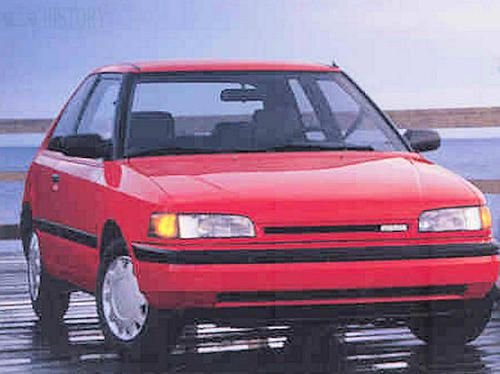 |
|
| Also called | Mazda 323 Mazda Protegé |
|---|---|
| Production | 1989–1994 |
| Assembly | Hiroshima, Japan Hofu, Japan Rayong, Thailand |
| Body style | 3-door hatchback 4-door sedan 5-door hatchback |
| Layout | Front-engine, front-wheel drive / All-wheel drive |
| Engine | 1.3 L B3 I4 1.5 L B5 I4 1.6 L B6 I4 1.8 L B8 SOHC I4 1.8 L BP DOHC I4 1.8 L BPT DOHC turbo I4 1.7 L PN diesel I4 |
| Transmission | 3-speed automatic 4-speed F-4EAT automatic 5-speed manual |
| Wheelbase | Hatchback: 2,450 mm (96.5 in) Sedan/F: 2,500 mm (98.4 in) |
| Length | Hatchback: 3,995–4,035 mm (157.3–158.9 in) Sedan: 4,215–4,355 mm (165.9–171.5 in) |
| Width | 1,670–1,690 mm (65.7–66.5 in) |
| Height | 1,340–1,405 mm (52.8–55.3 in) |
| Curb weight | 910–1,210 kg (2,006–2,668 lb) |
| Related | Mazda Familia Astina Eunos 100 Ford Laser Ford Escort/Ford Escort ZX2 Mercury Tracer Kia Sephia |
The sixth generation of Familia (BG) included a three-door hatchback, five-door fastback, and a four-door sedan variants, none of which shared any body panels. The new five-door fastback version was called the Familia Astina in Japan and was sold as the 323F or 323 Astina elsewhere. The BF wagon (originally introduced in 1985) was carried over in facelifted form, although Ford marketed a wagon on the new platform as part of the North American Escort line.
The BG Familia was available with front- or all-wheel drive and a 1.3 L, 1.5 L, 1.6 L, or 1.8 L gas or 1.7 L diesel engine. Later, a turbocharged engine was added, especially developed for homologation purposes for the World Rally Championship, Group A category. In North America, the 323 sedan became the Protegé, while the 323 hatchback kept its name. The four-wheel drive models (including the turbocharged GT-X) were introduced in August 1989. In Japan, the SOHC 1.6 was only available coupled to four-wheel drive. With a carburettor, it offered 91 PS (67 kW), the same as the lower-spec 1.5, but with a somewhat meatier torque curve.
Performance: 1600
- 63kW (84.5hp) [86PSJ at 5000rpm, 39.4kW/L (52.8hp/L) [53.8PS/L1; 123Nm (90.71bft) at 2500rpm
- Japanese version net): 62kW (83hp) at 5500rpm; 123Nm (90.71bft)
- USA version (SAE net): 61kW (82hp) [83PS1; 125Nm (92.21bft).
- Without catalyst (DIN): Compression ratio 10.5:1
- 77kW (103hp) [105PS1 at 6000rpm; 137Nm (101.11bft) at 4200rpm; leaded premium grade.
Performance:16V Turbo
- (Catalyst version) Max speed 106mph/170kmh
- power to weight ratio from 14.8kgkW (10.9kg/PS)
- acceleration 0 — 62mph/100kmh 9.5secs
- USA version (SAE net): 98kW (131hp) [134PSJ; 184Nm (135.61bft).
- Japanese version net): 103kW [140PSJ at 6000rpm; 186Nm (137.21bft)
- Without catalyst (DIN): 110kW (147hp) [150PSJ at 6000rpm,
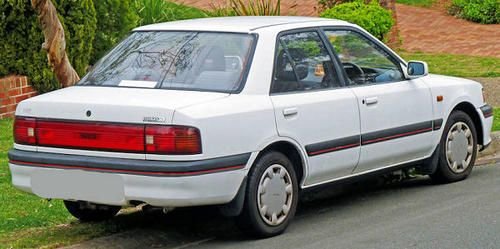
The GT model, only sold in Canada in 1990, 1991, and 1993, came with the 1.8 BP engine also found on the 1991–94 Ford Escort GT. It borrowed the interior from the GTX model, and had all factory options including a rear trunk spoiler that not available in the U.S. Ford also had a twin called the Laser in the Asian Pacific for this generation, but sold it in the United States as the Escort. It no longer resembled the Mazda versions externally. The Kia Sephia also used the hardware of this generation Familia.
Trim lines in Japan included Clair, Interplay, Supreme, "Pepper", and GT-X. Carburetted models were mostly dropped in 1991, replaced by single-point fuel injection.
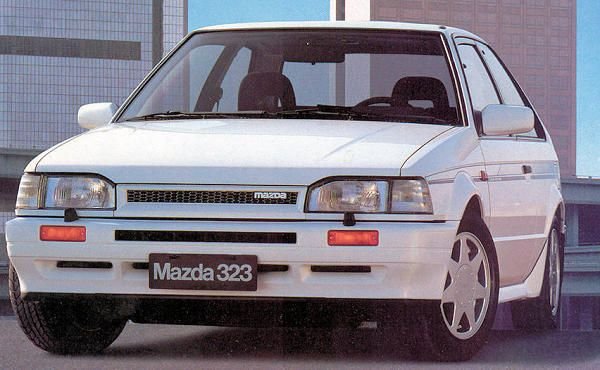
In America, base (SE/DX), 4WD and top-line LX models were available. The 1990 base model had the SE name. In 1991, the base model name was changed to DX. 4WD models existed for the 1990 and 1991 model years, with the SOHC engine and rear disc brakes. The LX version of the Protegé included a DOHC 16-valve 125 horsepower (93 kW) version of the SOHC 16-valve engine LX models also had power windows and door locks, 14 inch wheels, vented front and solid rear disc brakes, larger front brakes, larger clutch, equal-length driveshafts, dual outlet muffler, body-color door handles and mirrors, fold-down rear center armrest, driver's vanity mirror, and larger stabilizer bars. A sunroof and 14 inch aluminum alloy wheels were options on LX models.
BG models that were assembled in New Zealand came with glass headlights instead of plastic, and a 240 km/h speedometer.
Production of the 1994 model ended on May 24, 1994
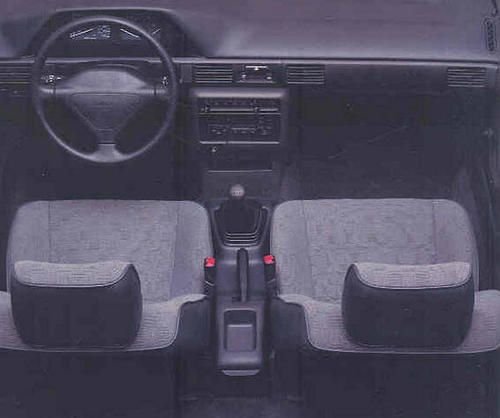
Familia Infini
The Mazda Familia Infini was produced from 1989 to 1990 as a special Japan only special sport trim line of the four-door Familia. Much of the Infini trim is similar to the American LX version, equipped with the 1.8 DOHC BP-ZE engine and 5-speed manual. The Infini was upgraded with a viscous limited slip differential, tightened suspension package, and bonnet/headlight style similar to the 323 hatchbacks. In 1994, these were facelifts were adopted to all Familia sedan models. The Infini came only in dark green color with unique Infini trim grille, rear spoiler, "lightweight" carpet, without sound deadener, and with Infini (∞) logos on horn button, front grille, wheel caps, and bootlid. There were also unique factory front clear indicators, a Momo steering wheel, BBS 15" rims, suede interior with GTX style seat trim, leather gearboot & knob, front and rear strut braces, 22 mm sway bars front and rear, rear tie bar, a 7,100 rpm redline tachometer, as well as 250 mm four-wheel disc brakes. Around 1,000 Infinis were produced.
Familia GTX, GTR and GT-Ae
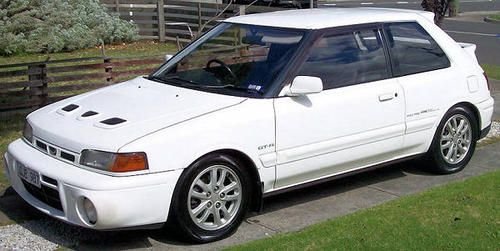
The JDM GTX model featured four-wheel drive, viscous limited slip differentials and a turbocharged 1.8 L BP engine. In the U.S. the Protegé came with a 1.8 L non-turbocharged engine, along with 4WD. The JDM GT-R rally homologation version was added in 1992, featuring a number of enhancements over the GTX model: a stronger gearbox (G5M-R), an aggressive front bumper, grill and bonnet vents, updated rear bumper, wheel flares, stiffer suspension and anti-roll bars with thicker cross members, and homologated five-stud wheel hubs with larger brakes. The interior was fitted with leather and suede seats, and had the option of replacing the cupholder with a 3 gauge cluster. In addition, the GTR has stronger connecting rods and pistons, larger oil squirters, larger nose crank, larger oil cooler, sodium filled valves, a baffled inlet manifold, larger injectors (from 360cc (black) to 440cc (orange)), removed boost cut, front-mounted intercooler, and an IHI VJ-23 ball bearing watercooled turbocharger. Both the GTX and GTR models were limited to a top speed of 180kph. However, removing a screw on the back of the instrument cluster, labeled 180kph, meant that the speed limiter was removed.
The GT-R produced 210 PS (154 kW) compared to the GTX with 185 PS (136 kW). 300 special version GT-R's were produced known as GT-Ae's. These shared the power output of the GT-R, but were 30 kg (66 lb) lighter, fitted with closer ratio gearboxes, and featured a larger top spoiler with a gap between the hatch and the spoiler to direct air to the new lower spoiler. The wiring for ABS, A/C, power mirrors, power windows, power locks, and sunroof was removed. Instead of using the GTR's leather interior, the lighter cloth interior of the GTX was used.
Familia Astina/323F
A sporty, five-door hatchback version was called the Familia Astina in Japan. Elsewhere, it was called 323F and 323 Astina. A luxury version was also sold in Japan as the (Japanese: Eunos 100). The car was produced from 1989 until 1994 before being replaced by the Lantis. A key feature of the Astina/F is the distinct front end with its pop-up headlights. There were carbureted or fuel injected SOHC versions available of the 1.5 and 1.6 liter engines, as well as a larger 1.8 litre DOHC version with fuel injection. Unlike the standard Familia saloons and three-door hatchback, the Astina never came from the factory with a turbo or with four wheel drive.
Taillight arrangement varies from market to market, the main difference being the third brake light in the spoiler and two brake lights per cluster (Japanese spec), rather than one.

Technical
-
-
Mazda 323 Familia 6th gen Technical details and specifications (1989-1994)
DIMENSIONS AND WEIGHT:
Wheelbase 240cm
track 139/141.5cm, 4WD track 139/142.5cm.
turning circle 9.4cm
load space 3/5-door 11.1-19.2cu ft (315-543dm3)
4-door 15.2cu ft (431dm3),
Estate/Station Wagon 27cu ft (764dm3)
length Hatchback 399cm
length 4—door Saloon/Sedan 419.5cm
length Estate/Station Wagon 422.5cm
width 164.5cm
height 139cm, Estate/Station Wagon 143cm. 4WD Height 140.5cm.
Body, Weight: from 830kg.
ENGINE:1300
49kW-66hr-67PS 1 2V Carb/Fuel Injection
4—cylinder in—line (71x83.6mm), 1323cm3
compression ratio 9.7:1
Without Catalyst (DIN):Compression ratio 9.4:1
For some countries (DIN): (77x69.4mm), 1296cm3
compression ratio 9.2:1
Engine construction: B 3 designation.
Transverse mounted front engine
Valves in V, hydraulic tappets, overhead camshaft (toothed belt)
light—alloy cylinder head
crankshaft with 5 bearings oil capacity 3.4L (3.2US qt)
1 downdraught 2V carb
catalyst version electronic fuel injection (Bosch L—Jetronic licence)ENGINE:1500
56kW-75hp-76PS 1 2V Catb
Engine data (JIS net):
4-cylinder in—line (78x78.4mm), 1498cm3
compression ratio 9.5:1; (75hp)
European version (DIN); compression ratio 9.1:1; 55kW (74hp) [75PS] at 5700rpm
For some countries (DIN): (77x80mm), 1490cm3; compression ratio 9:1; 55kW (74hp) [75PSl at 3500rpm.
Engine construction: B 5 designation.ENGINE: 1600
63mw-84.5/103hp-86/105ps Fuel injection
4-cylinder in-line (78x83.6mm), 1598cm3;
compression ratio 9.3:1
unleaded regular grade.
B 6 designation.
electronic (Bosch L—Jetronic licence) fuel injection.ENGINE: 16V Turbo
103/110kW-138/147hp-140/150PS Fuel Injection
(Catalyst, DIN): 4-cylinder in-line
(78x83.6mm), 1598cm3
compression ratio 7.9:1
Engine construction:
B 6 designation, DOHC (turbo)
4 valves per cylinder
2 overhead camshafts (toothed belt)
oil capacity 3.6L (3.4Us qt)
oil-cooler; 111-11
RHJB exhaust turbocharger
max boost pressure 0.6bar
charge-air cooler;
electronic fuel injection (Bosch L-Jetronic licence)ELECTRICAL EQUIPMENT:
Battery 12V 33-50Ah
alternator 50-60A
TRANSMISSION DRIVE LINE:
Drive:to front wheels
a) 4—speed manual, final drive ratio 4.105; 3.850.
Gear ratios: 4—speed manual: 1st 3.416; 2nd 1.842; 3rd 1.29; 4th 0.918; R 3.214
b) 5--speed manual, final drive ratio 4.105; 3.850.
Gear ratios:5-speed manual: 1st 3.416; 2nd 1.842; 3rd 1.29; 4th 0.918; 5th 0.731 or 0.775; R 3.214.
4WD: 5-speed manual, 1st 3.307; 2nd 1.833; 3rd 1233; 4th 0.914; 5th 0.775; R 3.166.
c) Automatic, hydraulic torque converter and 3-speed Planetary gear set
Automatic: Max torque multiplication in converter 2 times; Planetary gear set
ratios: 1st 2.841; 2nd 1.541; 3rd 1; R 2.4.
final drive ratio 1.3L-1.5L: 3.941; 3.631.
final drive ratio 1.6L: 4.388;4.105:auto 3.700 auto USA 3.849
CHASSIS SUSPENSION:
Integral body
all—round independent suspension; front MacPherson struts with lower A arms, some models with antiroll bars
rear coil springs, longitudinal double control arms, cornering stabilisers, telescopic dampers.BRAKES:
Servo/power assisted brakes
front discs (ventilated)
rear drums, mechanical 4WD rear disc brakes
handbrake to rear wheels
rack and pinion steering (optional power assisted)© Motor car History
- Engines
- 1989–1991 – 1.3 L (1,323 cc) B3, 1 barrel, 8-valve, 76 PS (56 kW) / 101 N·m (74 lb·ft)
- 1991–1994 – 1.3 L (1,323 cc) B3, EGI-S, 8-valve, 79 PS (58 kW) / 103 N·m (76 lb·ft)
- 1989–1991 – 1.5 L (1,498 cc) B5-M, carburetor, 16-valve, 91 PS (67 kW) / 122 N·m (90 lb·ft)
- 1990–1994 – 1.5 L (1,498 cc) B5-MI, EGI-S, 16-valve 94 PS (69 kW) / 123 N·m (91 lb·ft)
- 1989–1991 – 1.5 L (1,498 cc) B5-DE, EFi, 16-valve DOHC, 110 PS (81 kW) / 127 N·m (94 lb·ft)
- 1991–1994 – 1.5 L (1,498 cc) B5-DE, EFi, 16-valve DOHC, 115–120 PS (85–88 kW) / 132 N·m (97 lb·ft) (lower power for AT cars)
- 1989–1991 – 1.6 L (1,597 cc) B6, 1 barrel, 8-valve, 85 hp (63 kW; 86 PS) / 92 lb·ft (125 N·m)
- 1989–1994 – 1.6 L (1,597 cc) B6, FI, 16-valve SOHC, 103 hp (77 kW; 104 PS) / 108 lb·ft (146 N·m)
- 1989–1994 – 1.8 L (1,839 cc) BP, FI, 16-valve DOHC, 125 hp (93 kW; 127 PS) / 118 lb·ft (160 N·m)
- 1989–1994 – 1.8 L (1,839 cc) BPT, FI, 16-valve DOHC, turbo, 180 PS (132 kW) / 237 N·m (175 lb·ft) (Familia GT-X)
- 1991–1994 – 1.8 L (1,839 cc) B8, FI, 16-valve SOHC, 103 hp (77 kW)
- 1992–1993 – 1.8 L (1,839 cc) BPD, FI, 16-valve DOHC, turbo, 210 PS (154 kW) / 255 N·m (188 lb·ft) (Familia GT-R & GT-Ae)
- 1989–1994 – 1.7 L (1,720 cc) PN, Diesel, 8-valve, 57 PS (42 kW) / 112 N·m (83 lb·ft) (European specs)
-
Service
-
Mazda 323 Familia 6th gen Maintenance and Service Guide (1989-1994)
Oil capacity 1.6L: 3.61, (3.4US qt)
fuel tank 481. (10.5Gal) [127US Gall, Japan 45L (9.9Gal) [11.9US Gall
4WD fuel tank 50L (11Gal) [13.2US Gal]
tyres 6.15 13 or 155 SR 13, optional 175/70 SR 13, wheels 4.5 or 5J
4WD tyres 155 SR 13 or 175/70 SR 13
tyres 1.6L 175/70 SR 13 or 185/60 HR 14 (also USA 155 SR 13).
cooling system capacity 5L (4.7US qt)
cooling system capacity automatic 6L (5.7US Cit)
16V Turbo cooling system capacity 6L© Motor car History
